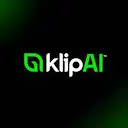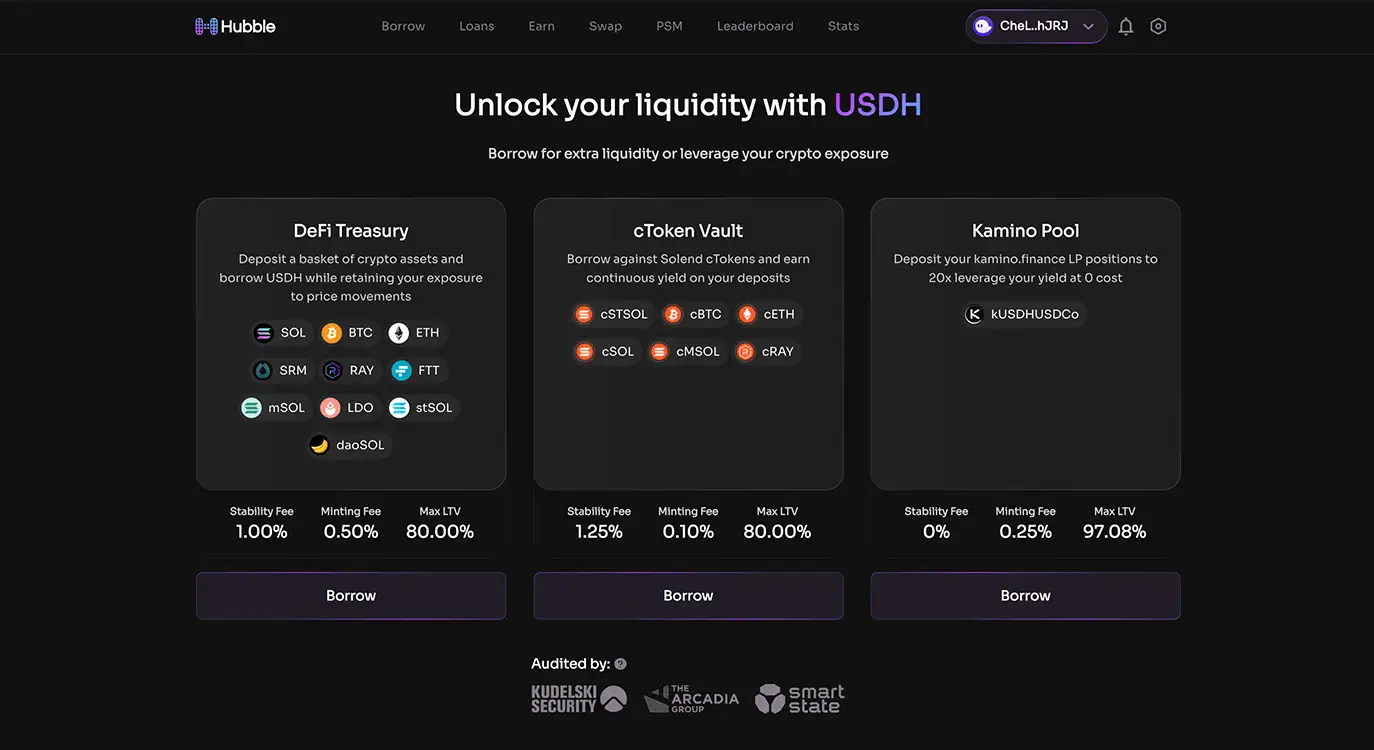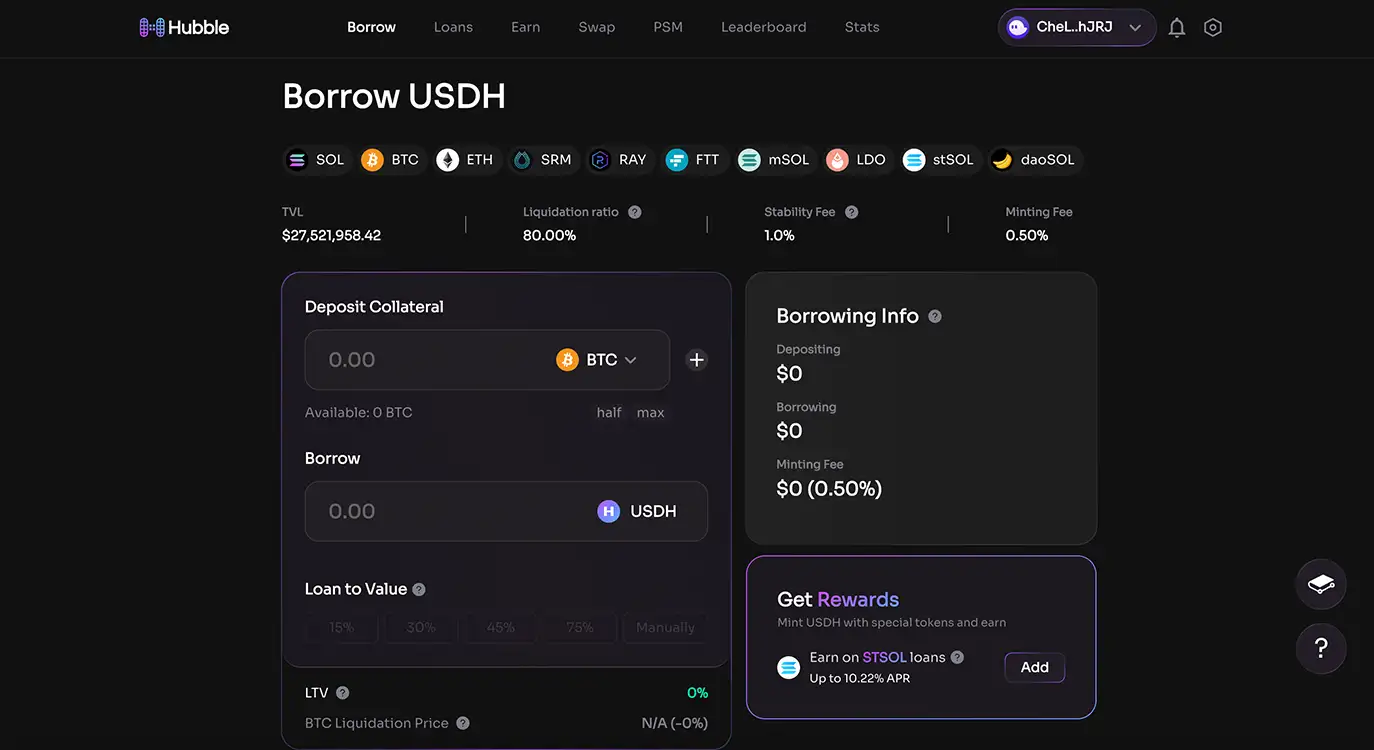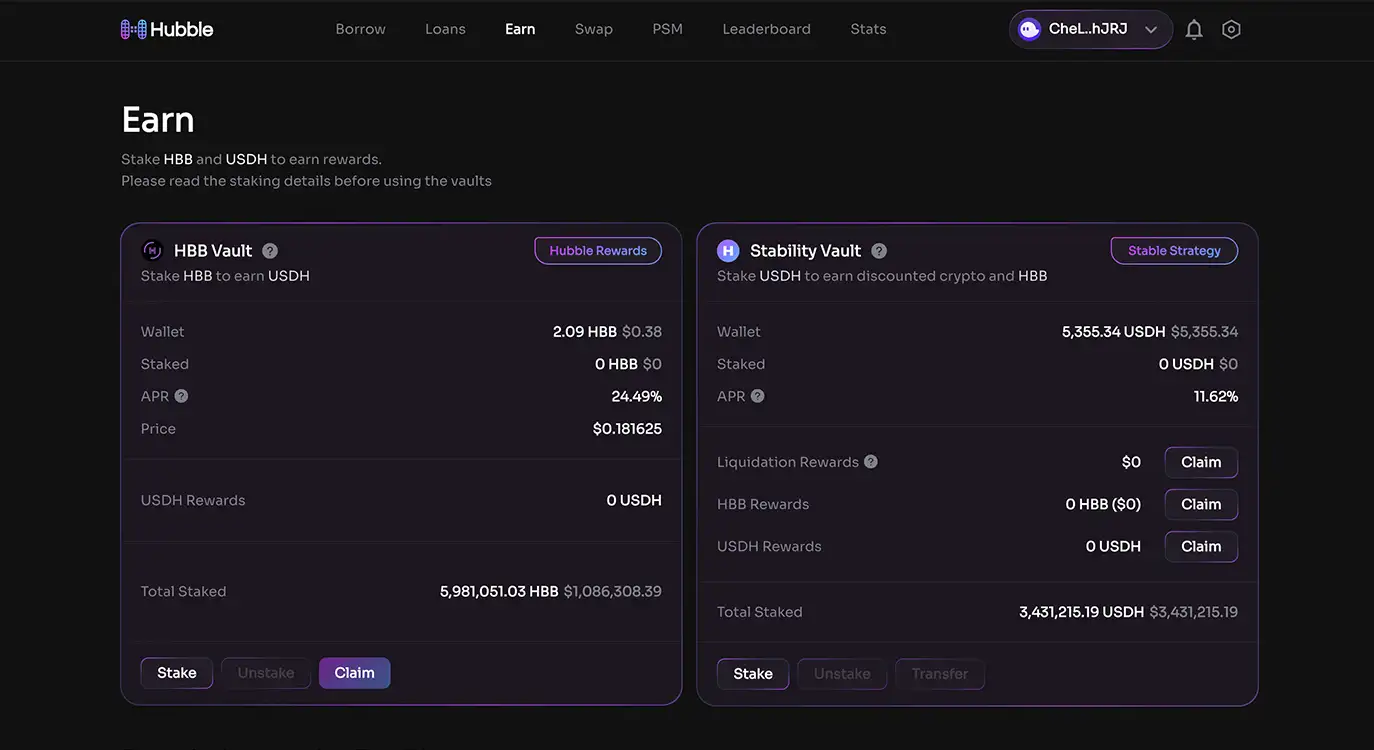About Hubble Protocol
Hubble Protocol is a decentralized finance (DeFi) platform built on the Solana blockchain, focusing on capital efficiency and decentralized stablecoin minting. It offers users the ability to deposit a range of crypto assets as collateral to mint USDH, a Solana-native decentralized stablecoin pegged to the US dollar. The protocol aims to empower users by providing a suite of DeFi products, including borrowing, staking, and yield-generating opportunities, all while maintaining decentralization and user control over funds.
Hubble Protocol stands out in the DeFi landscape with its high loan-to-value (LTV) ratios, enabling users to borrow more against their collateral compared to many other platforms. The project’s integration with Solana allows it to deliver fast, low-cost transactions while scaling to meet the demands of both new and advanced users. Hubble’s mission is to build a decentralized economy where financial tools are permissionless, secure, and efficient, providing users with a wide range of possibilities for leveraging their digital assets.
In summary, Hubble Protocol is designed for DeFi enthusiasts who seek to unlock liquidity from their crypto assets while participating in a decentralized and capital-efficient ecosystem. Its flexible collateral options, seamless Solana integration, and diverse financial tools make it a compelling choice in the Solana DeFi space.
Hubble Protocol was conceived to solve major issues in the decentralized finance (DeFi) ecosystem, particularly around capital inefficiency and limited collateral options in lending platforms. The project launched with the vision of creating a protocol that maximizes capital efficiency, offers decentralized stability, and provides a user-friendly environment for both new and experienced DeFi participants.
At its core, Hubble Protocol enables users to mint USDH, a decentralized stablecoin, by depositing a wide variety of crypto assets as collateral. USDH is pegged to the US dollar, allowing users to maintain liquidity while holding onto their crypto assets. The minting process is fully decentralized and non-custodial, ensuring that users have complete control over their funds without relying on any third parties.
The platform’s standout feature is its competitive loan-to-value (LTV) ratios. Compared to many other platforms, Hubble allows users to borrow more against their collateral, enhancing capital efficiency. This is particularly beneficial in volatile markets, where maintaining liquidity while maximizing asset value is crucial. Users can choose from a wide array of collateral types, including popular tokens on Solana such as SOL, BTC, ETH, and others, providing flexibility and choice.
Since its launch, Hubble Protocol has steadily expanded its ecosystem, integrating more assets and developing additional features to enhance user experience. These include yield farming, staking, and liquid staking opportunities, where users can earn rewards in a decentralized manner. The platform’s development is guided by the principles of security, scalability, and decentralization, with continuous improvements aimed at staying competitive in the fast-paced DeFi landscape.
What sets Hubble Protocol apart from competitors like Anchor Protocol (for Terra) and MakerDAO (for Ethereum) is its unique position on the Solana blockchain. Solana’s high throughput and low transaction costs make Hubble more accessible and efficient for users. Moreover, Hubble’s ability to support multiple collateral types allows it to cater to a broader user base compared to protocols that are limited in terms of what assets they accept as collateral.
Hubble Protocol’s growth has also been marked by strategic integrations with other Solana-based projects, which expands its reach and user base. The platform’s governance model is designed to be fully decentralized, with plans for community-driven decision-making in future upgrades. As the protocol evolves, it aims to offer even more diverse financial tools, ensuring that it remains a cornerstone of the Solana DeFi ecosystem.
- Minting USDH Stablecoin: Users can deposit a wide range of supported crypto assets as collateral to mint USDH, a decentralized stablecoin pegged to the US dollar. The minting process is straightforward and permissionless.
- Competitive Loan-to-Value (LTV) Ratios: Hubble’s high LTV ratios allow users to borrow more against their collateral, making it one of the most capital-efficient platforms in the market. Users can manage their LTV to avoid liquidation while maintaining optimal borrowing power.
- Multi-Collateral Support: The protocol supports an extensive array of assets, including SOL, BTC, ETH, and other popular Solana tokens, giving users the flexibility to leverage their diverse portfolios without needing to liquidate their holdings.
- Decentralized and Non-Custodial: Hubble is fully decentralized, ensuring users retain complete control over their assets at all times. The platform is non-custodial, meaning that users are never reliant on intermediaries to manage their funds.
- Seamless Solana Integration: Operating on the Solana blockchain, Hubble leverages Solana’s speed, scalability, and low transaction costs. This integration allows users to enjoy fast, cost-effective transactions while minting, borrowing, or participating in yield opportunities.
- Yield Opportunities: Beyond minting and borrowing, Hubble offers various yield-generating opportunities, including staking and farming. Users can stake their assets or participate in liquidity pools to earn additional rewards, adding layers of profitability within the ecosystem.
- Liquid Staking and Governance: Hubble also provides options for liquid staking, where users can stake their assets and still maintain liquidity. Additionally, the platform is gradually evolving toward full decentralization, with governance features planned for community participation in key decisions.
- Set Up a Solana-Compatible Wallet: If you don’t already have one, create a Solana-compatible wallet like Phantom or Solflare. Follow the setup instructions and ensure your wallet is funded with SOL tokens, which will be needed to cover transaction fees for all activities on the Solana blockchain.
- Access the Hubble Protocol Interface: Visit the Hubble Protocol app and connect your Solana wallet. Upon connecting your wallet, the platform will provide a seamless and intuitive interface to manage your assets and collateral.
- Deposit Collateral: Choose the type of collateral you want to deposit from the supported assets. Hubble Protocol supports popular Solana tokens like SOL, BTC, ETH, and more. After selecting your preferred asset, specify the amount you want to deposit as collateral and complete the deposit process.
- Mint USDH Stablecoin: With your collateral deposited, you can now mint USDH. Enter the amount of USDH you wish to mint, ensuring that your loan-to-value (LTV) ratio remains at a safe level to avoid liquidation risks. The platform will automatically calculate your collateralization ratio based on the amount of USDH minted.
- Explore Yield Opportunities: After minting USDH, you can stake it, participate in yield farming, or explore other features offered by the Hubble Protocol. The platform offers various staking options and liquidity pools where you can earn additional rewards. For more detailed instructions, refer to the official Hubble documentation.
- Monitor and Manage Your Positions: Regularly check your collateralization ratio and overall position. Hubble Protocol provides a dashboard where you can easily view and manage your collateral, loans, and rewards. You can also make adjustments or repay your loan to avoid liquidation risks.
Hubble Protocol Reviews by Real Users
Hubble Protocol FAQ
The USDH stablecoin is unique because it’s fully decentralized and backed by a diverse pool of assets on the Solana blockchain. Unlike other stablecoins that might rely on centralized reserves or a single asset as collateral, USDH is minted using multiple crypto assets, providing flexibility and better stability. This decentralized collateral pool ensures that users maintain control while benefiting from a resilient and scalable system.
Hubble Protocol leverages the high throughput and efficiency of the Solana network, allowing it to offer some of the most competitive LTV ratios in the market. The platform’s robust risk management framework continually monitors collateral to ensure that loans remain secure even during volatile market conditions. Additionally, users have full control over managing their LTV ratios with easy-to-use tools, which minimizes the risks of liquidation.
Hubble Protocol recognizes that DeFi users have diverse portfolios, so supporting a wide range of collateral types allows more users to participate in the ecosystem without needing to convert or sell their preferred assets. Whether you hold SOL, BTC, ETH, or other supported tokens, you can deposit them as collateral to mint USDH. This flexibility makes Hubble more inclusive and adaptable to a broader user base.
Liquid staking on Hubble Protocol allows users to stake their assets while still retaining liquidity, meaning they can continue using those assets in DeFi activities. For instance, you can stake SOL and still participate in yield farming or use the staked tokens as collateral to mint USDH. This dual benefit system lets you earn staking rewards while keeping your assets productive in other DeFi opportunities, maximizing your overall returns.
Hubble Protocol is progressively moving towards full decentralization, where the community will play a key role in governance and decision-making. As the protocol grows, governance tokens will be introduced to allow users to vote on protocol upgrades, new collateral types, and other crucial changes. This community-driven approach ensures that the protocol evolves in line with users' needs and maintains decentralization as a core principle.
You Might Also Like












